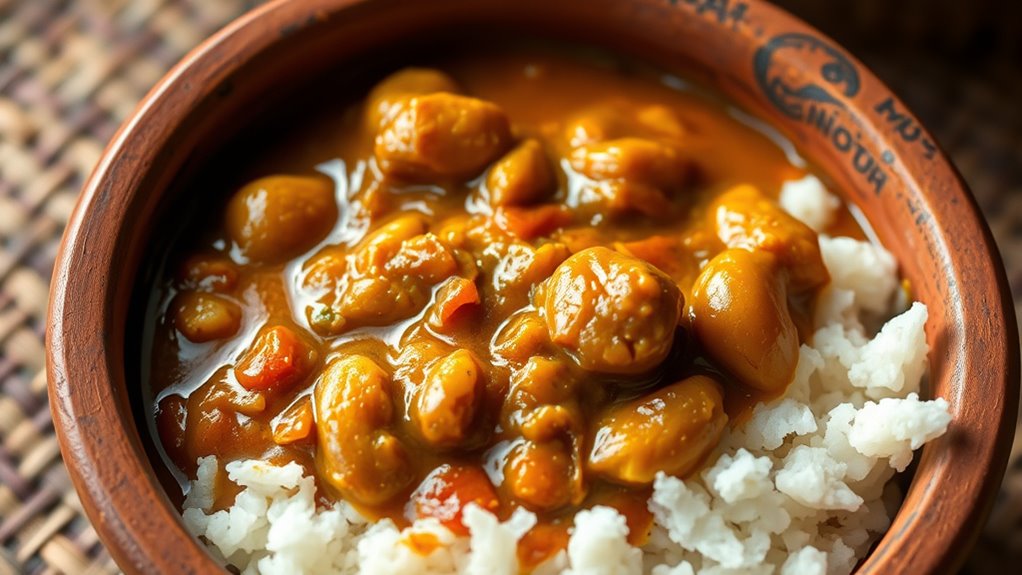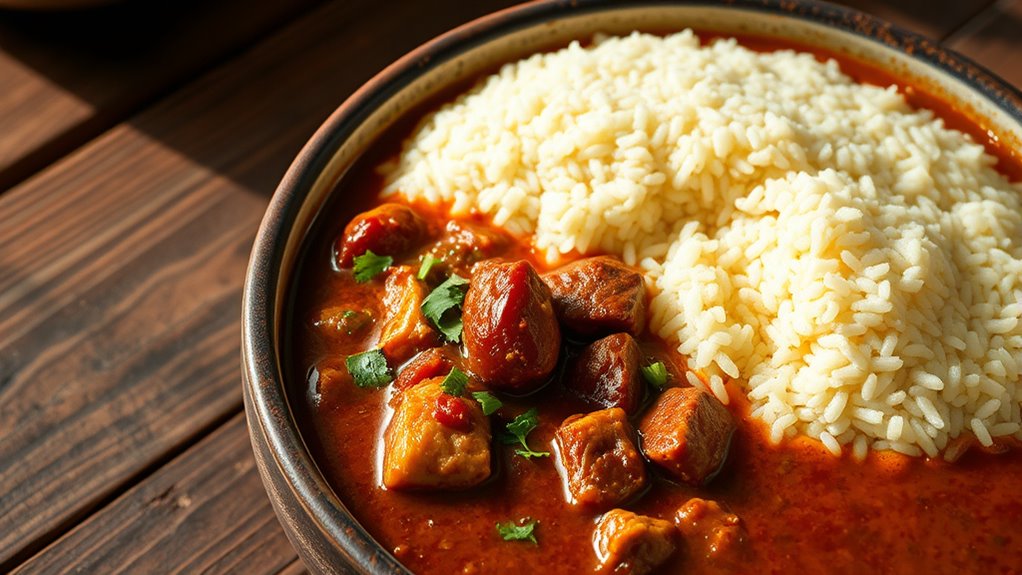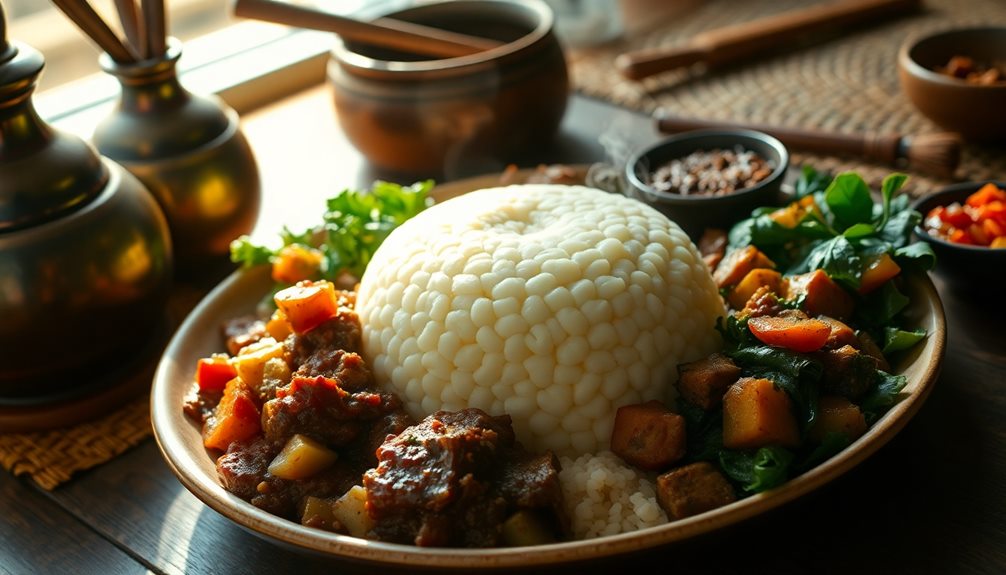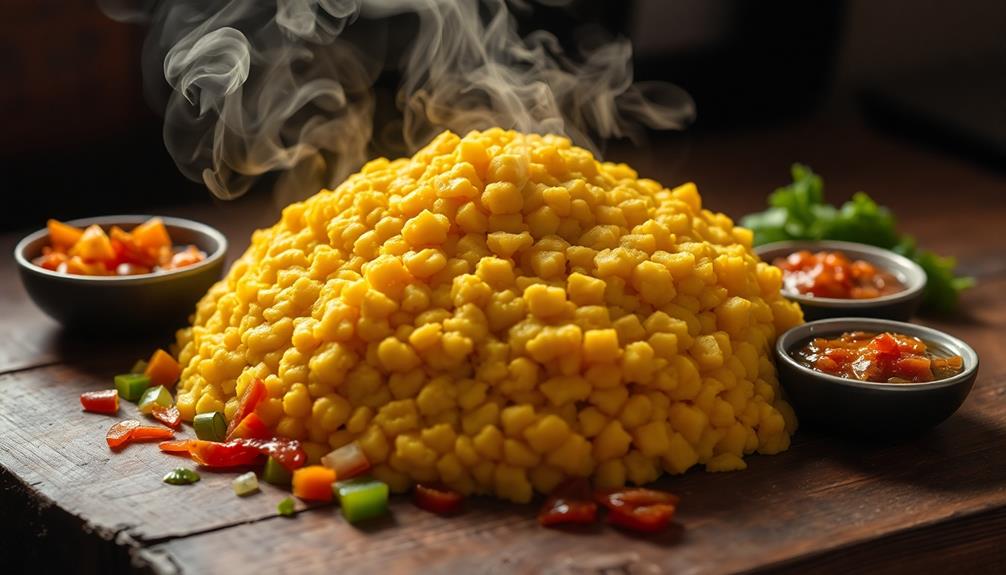Zimbabwean peanut stew, called dovi, is a flavorful, hearty dish made with peanuts, vegetables, and often lean meats like chicken or beef. It’s simmered to develop a rich, nutty aroma and thickened sauce, creating a comforting meal. When served with sadza, it embodies hospitality, community, and cultural bonding. This dish not only connects you to Zimbabwean traditions but also offers nutritional benefits. Keep exploring to discover more about its history, preparation, and significance.
Key Takeaways
- Dovi is a traditional Zimbabwean peanut stew rich in flavors, often served with sadza for a complete, hearty meal.
- The dish features a peanut-based sauce simmered with vegetables and meats, enhancing taste and nutritional value.
- It embodies Zimbabwean culture, fostering community bonds and family gatherings around the meal.
- Nutrient-rich ingredients like peanuts, vegetables, and lean meats support overall health and well-being.
- Serving Dovi with sadza creates a balanced, filling dish that exemplifies Zimbabwean culinary heritage.

Zimbabwean peanut stew, also known as Dovi, is a hearty and flavorful dish that brings together rich, creamy peanut sauce with tender vegetables and meat. As you prepare and enjoy this traditional meal, you’ll quickly realize its deep cultural significance. Dovi isn’t just food; it’s a symbol of community and heritage. In Zimbabwe, families often gather around the pot, sharing stories and bonds while the stew simmers. It’s a dish that connects generations, preserving culinary traditions and fostering a sense of identity. When you serve Dovi with sadza, the staple maize porridge, you’re participating in a culinary practice that embodies Zimbabwean hospitality and unity. The act of sharing this meal reinforces social ties, making it more than just nourishment—it’s a cultural experience that celebrates togetherness and resilience.
Beyond its cultural importance, Dovi also offers notable nutritional benefits. The peanut base provides a rich source of plant-based protein, essential for muscle repair and overall health. Peanuts are packed with healthy fats, which support heart health and help keep you feeling full longer. When combined with vegetables like tomatoes, onions, and greens, the stew becomes a well-rounded dish that supplies crucial vitamins and minerals. These nutrients boost your immune system and promote good digestion, making Dovi a wholesome option for balanced eating. If you include lean meats such as chicken or beef, you add extra protein and iron, essential for energy production and blood health. The dish’s ingredients are simple but potent, offering a nutritious profile that sustains and energizes you through busy days or restful weekends alike.
You might also notice how the flavors develop further as the ingredients simmer, creating a rich cultural significance that is characteristic of Zimbabwean cuisine. As you cook Dovi, you’ll notice how the peanut sauce thickens and develops a rich, nutty aroma that coats the vegetables and meat beautifully. The process of simmering melds flavors, creating a comforting, satisfying dish. When paired with sadza, the thick maize porridge, it becomes a balanced meal that fills you up while nourishing your body. This combination exemplifies the Zimbabwean approach to food—simple ingredients transformed into something hearty and meaningful. Whether you’re preparing it for a family gathering or a quiet dinner, you’re engaging with a dish that’s deeply rooted in Zimbabwean history and health. By choosing Dovi, you honor a culinary tradition that’s both culturally significant and nutritionally beneficial, connecting your palate to Zimbabwe’s rich heritage and supporting your well-being at the same time.
Frequently Asked Questions
What Are the Key Nutritional Benefits of Dovi?
Dovi offers you impressive nutrient density, providing essential vitamins and minerals that support your health. Its main ingredient, peanut protein, helps boost your muscle repair and keeps you feeling full longer. Eating dovi regularly can improve your heart health due to healthy fats, while its rich nutrients support your immune system. Overall, it’s a delicious way to get a nutritious, protein-packed meal that benefits your overall wellness.
Can Dovi Be Made Vegan or Vegetarian?
Imagine transforming a hearty, soulful dish into a vibrant celebration of plant power. Yes, you can make Dovi vegan or vegetarian using vegan substitutions like coconut milk or vegetable broth. For vegetarian options, add hearty vegetables or plant-based proteins. These tweaks let you enjoy the rich, creamy flavor of Dovi while honoring your dietary choices, turning every spoonful into a warm, compassionate hug for your taste buds.
What Are Traditional Variations of Sadza?
You can explore various traditional sadza variations by experimenting with different grain varieties like millet, sorghum, or maize. Each grain offers a unique flavor and texture, enriching your dish. Use distinct cooking techniques, such as slow stirring or fermentation, to achieve the perfect consistency and taste. These variations connect you deeply to Zimbabwean culinary heritage, allowing you to customize sadza while honoring its rich cultural roots.
How Long Does Dovi Typically Take to Prepare?
Think of dovi as a slow dance, where patience leads to flavor. Preparation time for dovi usually takes about 10-15 minutes, while cooking duration spans roughly 30-45 minutes, depending on how thick you want your stew. The longer you cook, the richer the taste becomes. So, set aside enough time to let the flavors meld, creating a dish that’s worth every minute invested.
Are There Regional Differences in Dovi Recipes Across Zimbabwe?
Yes, you’ll notice regional flavor variations and ingredient substitutions in dovi recipes across Zimbabwe. In some areas, cooks add spicy peppers or local herbs to enhance flavor, while others might replace peanuts with groundnut paste. These regional differences give each version a unique taste, so you can experiment by trying different ingredients to find the flavor profile that suits your preference best.
Conclusion
As you savor each bite of the rich peanut stew and hearty sadza, you’re transported to Zimbabwe’s vibrant heart. This dish isn’t just a meal; it’s a story of tradition, community, and warmth wrapped in every spoonful. So next time you sit down to enjoy it, remember—you’re tasting more than food; you’re experiencing a culture’s soul. And isn’t that what makes every bite truly unforgettable?










